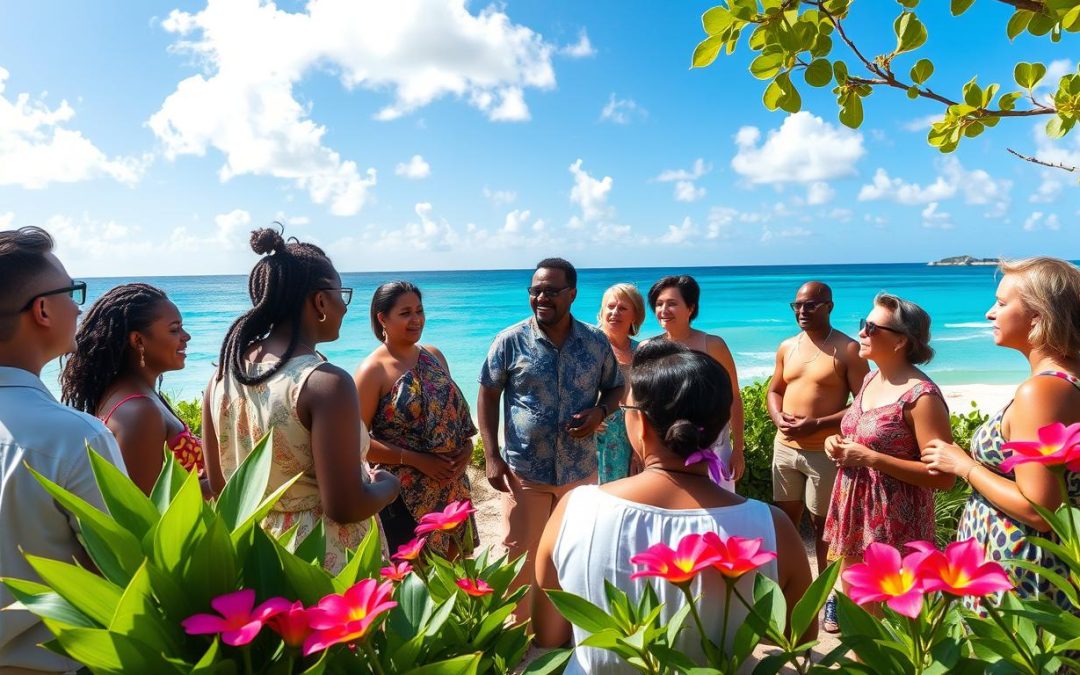Ever thought about how a small Caribbean island handles its languages? Anguilla is a great example of language complexity that’s more than just talking.
In Anguilla, English is the main language used by everyone. With only 15,753 people, the island shows a wide range of languages. This shows its deep cultural roots.
The English spoken here has a British twist, showing the island’s history. Officially, Standard English is used everywhere. But, locals also speak their own Anguillan Creole, known by about 10,000 people.
Exploring Anguilla’s languages shows a colorful mix of old traditions and new cultures. It’s a lively example of how languages can come together.
Key Takeaways
- Standard English is the official language of Anguilla
- Anguillan Creole is spoken by less than 10,000 residents
- The island demonstrates significant linguistic diversity
- British colonial history influences local language patterns
- Multiple immigrant languages contribute to the linguistic landscape
Understanding Anguilla’s Linguistic Heritage
Anguilla’s language scene is a colorful mix of cultures and history. It shows the island’s journey from its indigenous roots to its current cultural mix.
Historical Development of Language
The language of Anguilla goes back to the Amerindian people who arrived around 1300 BC. They brought their own languages and ways of talking. This started the island’s rich language diversity.
- Indigenous Amerindian settlement around 1300 BC
- Evidence of permanent settlements dating to AD 600
- Early cultural exchanges shaping language development
Cultural Impact on Language Evolution
Caribbean languages have greatly influenced Anguilla’s language. The island’s history of different cultures has made its language complex and unique.
“Language is the road map of a culture. It tells you where its people come from and where they are going.” – Rita Mae Brown
Colonial Influence on Local Speech Patterns
British rule has shaped Anguilla’s language and communication. Today, over 90% of people speak a British English dialect. This has given the island a special language identity.
| Language Characteristic | Percentage |
|---|---|
| English Dialect Speakers | 90% |
| Creole Language Speakers | Significant Minority |
| Literacy Rate | 95% |
This has created a fascinating language scene. It shows Anguilla’s changing culture and its global connections.
English as the Official Language of Anguilla
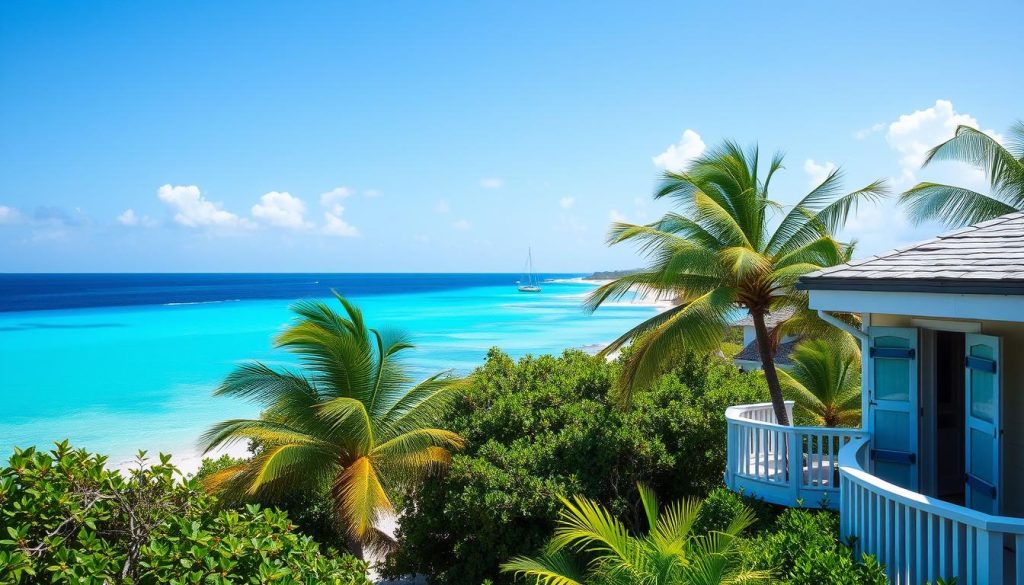
English is key in Anguilla, playing a big role in daily life. The island’s rules make English the official language, showing its British roots. High literacy rates in English help everyone communicate well.
Knowing about Anguilla’s language starts with its official status. English is vital in many areas:
- Government administration
- Educational instruction
- Media communications
- Tourism industry interactions
The English spoken in Anguilla has its own twist. Anguillan English has its own sound and words that differ from British English. This comes from the island’s culture and ties with other Caribbean places.
“Language is the roadmap of a culture. It tells you where its people come from and where they are going.” – Rita Mae Brown
For Anguilla’s tourism, speaking English well is a big plus. It helps draw visitors and boosts the economy. About 14% of West Indians speak English, making Anguilla’s language scene unique in the Caribbean.
| Language Characteristic | Anguilla’s Status |
|---|---|
| Official Language | English |
| Linguistic Influence | British Colonial Heritage |
| Communication Sectors | Government, Education, Tourism |
Understanding English’s role in Anguilla sheds light on the island’s culture and how people talk to each other.
The Unique Features of Anguillan Creole
Anguillan Creole is a special language in the Caribbean. It comes from a mix of cultures, showing how history shapes how we talk. With only about 10,000 speakers, it gives a peek into the island’s rich language history.
Grammatical Structure and Rules
Anguillan Creole’s grammar is quite different from English. It has:
- Simplified verb conjugations
- Unique pronoun usage
- Condensed sentence structures
- Rhythmic speech patterns
Common Phrases and Expressions
Anguillan Creole is full of creative language. Its sayings show the island’s culture, mixing African and Caribbean influences.
“Wi deh ya” – A common greeting meaning “We are here”
Pronunciation Patterns
The way Anguillan Creole is spoken is musical. Speakers:
- Emphasize certain syllables uniquely
- Use distinct vowel sounds
- Incorporate rhythmic intonations
Learning Anguillan Creole helps us understand Creole languages better. It shows how they keep cultural identities alive.
Language Demographics and Usage Statistics
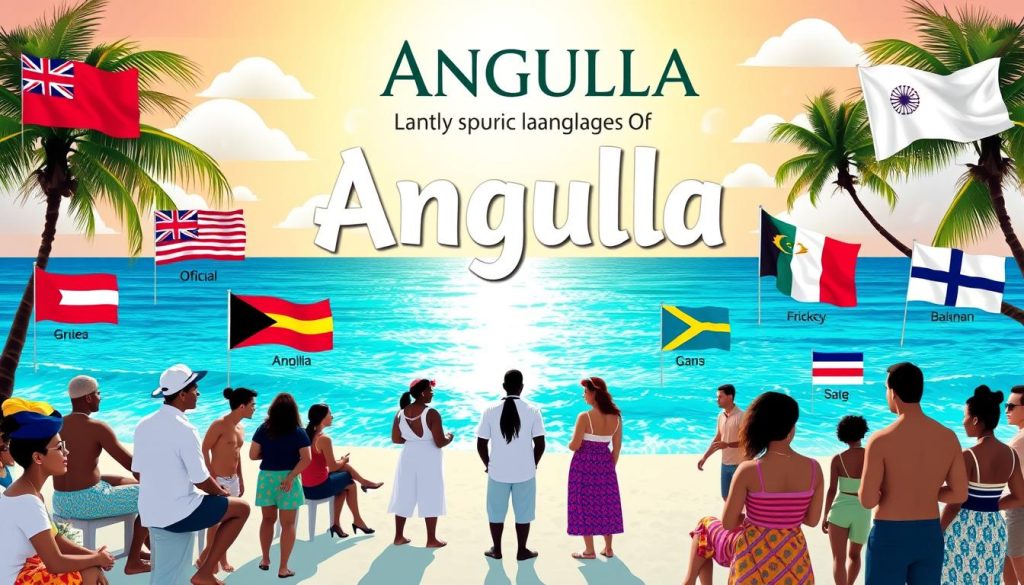
Anguilla is a place of rich linguistic diversity. English is the main language for most people. About 92% of the population speaks English first, showing the island’s strong language base.
The language scene in Anguilla is quite interesting. English is the main one, but 7% speak Spanish, Creole, or other languages. This shows the island’s subtle mix of languages.
- Total population: Approximately 15,753 residents
- English speakers: 11,329 individuals
- Bilingual residents: 881 individuals
Language education is key to keeping diversity alive. The island has a high literacy rate of 95%. This helps everyone learn and communicate well in different areas.
“Language is the road map of a culture. It tells you where its people come from and where they are going.” – Rita Mae Brown
Language use varies by sector, but remains consistent:
- Education: 100% English proficiency
- Government: 100% English proficiency
- Business: 95% English proficiency
The linguistic diversity index is low, with less than three main languages. This shows a focused environment that values clear communication and cultural richness.
Anguilla: Official and widely spoken languages
Exploring Anguilla’s language scene reveals a rich mix of communication styles. This mix reflects the island’s unique cultural heritage. With about 15,000 people, Anguilla shows great linguistic diversity, despite its small size.
Anguilla’s language profile is shaped by its history. English is the official language, spoken by 99% of the people. Anguillan Creole, a vibrant dialect, captures the island’s complex cultural roots.
Current Language Distribution
Anguilla’s language landscape is complex:
- Standard English: Primary official language
- Anguillan Creole: Local dialect with deep cultural significance
- Traces of Caribbean linguistic influences
Regional Language Variations
Anguilla’s different regions have their own language variations. These variations show the island’s rich history. It has been influenced by British colonizers, African descendants, and Caribbean neighbors.
Sociolinguistic Patterns
Language in Anguilla is more than just a way to communicate. It’s a way to express culture. The mix of standard English and local dialects shows complex social dynamics. Language choices often show identity, social status, and community belonging.
“Language is the road map of a culture. It tells you where its people come from and where they are going.” – Rita Mae Brown
Understanding Anguilla’s language gives insight into its vibrant social fabric. It shows how language changes through history, culture, and social interactions.
Education and Language Policy in Anguilla
Anguilla’s language education system is designed to keep literacy high and protect its language heritage. The island focuses on teaching standard English but also values Anguillan Creole.
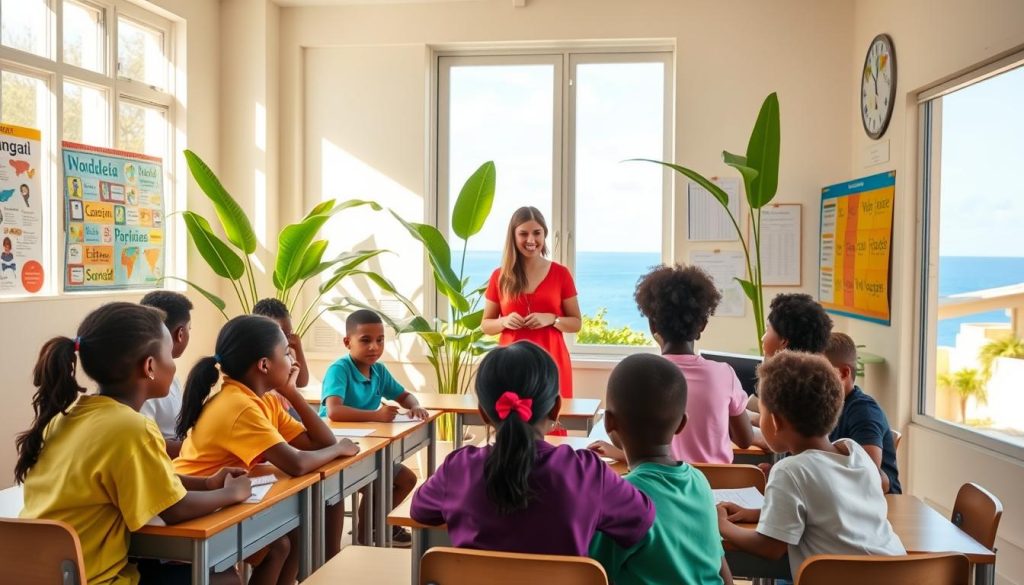
The language policies in Anguilla’s schools aim to achieve several goals:
- Emphasizing standard British English as the primary medium of instruction
- Recognizing the importance of local linguistic traditions
- Developing comprehensive language education programs
Caribbean schools face big challenges in teaching languages. About 53% pass the Caribbean Secondary Education Certificate (CSEC) English Language Exam. This shows the tough job of teaching languages.
Language is not just a communication tool, but a bridge between cultural identity and academic success.
Literacy is a big deal in Anguilla’s schools. They aim to keep English skills sharp while honoring local languages.
| Language Education Aspect | Anguilla’s Approach |
|---|---|
| Primary Language of Instruction | Standard British English |
| Local Language Recognition | Anguillan Creole acknowledged |
| Language Policy Goal | Maintain high literacy rates |
Anguilla’s language policies are inspired by global standards. They follow the United Nations Charter and Universal Declaration of Human Rights. These documents stress the importance of language rights and fair education.
Anguilla’s education strikes a fine balance. It keeps local language traditions alive while preparing students for the world.
Influence of Caribbean Languages on Anguillan Speech
The language of Anguilla is a mix of many Caribbean languages. Exploring Anguillan speech shows interesting links to other island dialects. This highlights the area’s rich linguistic diversity.
Anguilla’s language has deep roots in Caribbean traditions. Its speech is unique because of its complex heritage.
Connection to Leeward Islands Dialects
Anguillan speech is similar to other Leeward Islands dialects. It’s a part of Leeward Caribbean Creole English but has its own special traits:
- Close ties to British Virgin Islands dialects
- Influences from Saint Martin’s speech
- Unique grammatical structures from regional exchanges
Shared Linguistic Features
Anguilla’s language shares interesting traits with other Caribbean languages:
| Linguistic Feature | Characteristic |
|---|---|
| Phonological Patterns | Rhythmic intonations like nearby islands |
| Vocabulary | Unique words from various Caribbean sources |
| Grammatical Structures | Special syntax from regional language exchanges |
Regional Language Exchange
Caribbean languages are always changing. Anguilla’s speech shows how culture and language mix, creating a living linguistic ecosystem that grows and changes.
“Language is the road map of a culture. It tells you where its people come from and where they are going.” – Rita Mae Brown
Learning about these language connections helps us understand Anguilla’s rich culture. Your exploration of Anguillan speech opens a door to a world of linguistic diversity that captivates both researchers and language lovers.
Modern Language Trends and Evolution
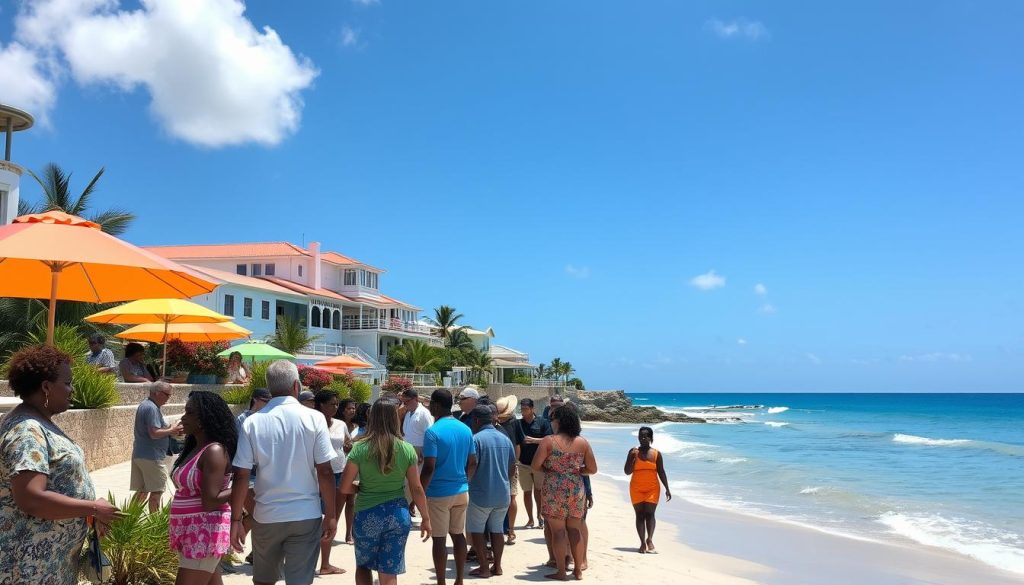
Digital technology is changing language education and multilingualism in Anguilla. Young islanders are seeing big changes in language thanks to the internet and new tech.
Social media and digital tools have made language policies and communication change fast. Anguillans are now seeing how important being multilingual is in today’s world.
“Language is the roadmap of a culture. It tells you where its people come from and where they are going.” – Rita Mae Brown
- Increasing digital communication platforms
- Growing importance of multilingual competencies
- Technological influences on language learning
- Enhanced global communication strategies
Language education in Anguilla is now about getting ready for the world. Schools use new digital tools to help students learn languages fast and understand different cultures.
| Language Trend | Impact | Future Projection |
|---|---|---|
| Digital Communication | Increased Exposure | Broader Linguistic Skills |
| Global Connectivity | Multilingual Competence | Enhanced Career Opportunities |
| Technology Integration | Interactive Learning | Adaptive Language Policies |
The island’s language scene is always changing. It’s a mix of old ways of talking and new tech.
Impact of Tourism on Language Use
Tourism changes Anguilla’s language scene, mixing local and international ways of speaking. The island’s tourism boom boosts multilingualism and language variety, especially in service jobs.
Knowing English well is key for locals in the hospitality and tourism fields. Visitors from all over add to the mix, helping locals improve their language skills.
- Increased English usage in service industries
- Enhanced multilingual communication skills
- Cultural language interactions
The tourism industry pushes locals to get better at talking to people from different places. Visitors bring their own language styles, making communication more lively and adaptable.
“Language is the roadmap of a culture. It tells you where its people come from and where they are going.” – Rita Mae Brown
| Language Impact Area | Tourism Influence |
|---|---|
| English Proficiency | Significant Improvement |
| Linguistic Diversity | Enhanced Interaction |
| Communication Skills | Expanded Capabilities |
Anguilla’s language world keeps growing, with tourism at the heart of it. The island keeps its language traditions alive while welcoming new language trends.
Multilingual Communities in Anguilla
Anguilla’s language scene is a colorful mix of cultures. With 15,753 people, the island values speaking many languages. Standard English is official, but many immigrants add to the mix.
The language scene in Anguilla goes beyond usual limits. It’s a place of learning and sharing cultures.
Immigrant Language Groups
Anguilla is home to many immigrant groups. These groups add to the island’s language variety:
- Spanish-speaking immigrants
- Chinese language communities
- Various Caribbean dialect speakers
Language Integration Patterns
Language blending in Anguilla is special. Newcomers often learn Anguillan Creole and Standard English. They keep their own languages too.
| Ethnic Group | Percentage | Primary Languages |
|---|---|---|
| Black | 85.3% | English, Anguillan Creole |
| Hispanic | 4.9% | Spanish, English |
| Mixed | 3.8% | Multilingual |
| White | 3.2% | English |
Cultural Exchange Through Language
Language connects Anguilla’s communities. People’s interactions make the island a lively place. It celebrates different languages and understanding.
“Language is the road map of a culture. It tells you where its people come from and where they are going.” – Rita Mae Brown
Conclusion
Anguilla’s languages show how cultures can stay strong and change. You’ve seen how the island’s language history is a mix of British, Caribbean, and local influences. This mix of English and Anguillan Creole shows the island’s unique identity.
Language policies in Anguilla are very flexible. With only about 10,000 Creole speakers, the island keeps its language alive. At the same time, it uses British English for everyday talks. This shows how the island’s mostly Black people (85.3%) keep their culture alive through language.
Exploring Anguilla’s languages shows language’s role in history, identity, and community. The island finds a balance between keeping local dialects and joining global talks. This makes Anguilla a special example of cultural adaptation in the Caribbean.
Learning about Anguilla’s language journey teaches us about small communities’ cultural strength. The island’s language is always changing, showing the people’s resilience and ability to adapt.
The above is subject to change.
Check back often to TRAVEL.COM for the latest travel tips and deals.
Here are some Tours & Sightseeing suggestions that might pique your interests!
